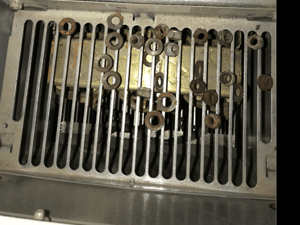Motion Control Tips recently published a tongue-in-cheek article called "How to kill your favorite variable frequency drive." (You read that right.) It has a lot of good suggestions of things not to do if you want your drive to live, written in a fun-to-read facetious style. Our favorite: letting quarters, washers, or other small conductive objects fall through the vents on top of the VFD, where they can short out the DC bus.
 One thing that was beyond the scope of that article was the motor at the far end of the drive-motor system. Which begs the question: Why keep a VFD alive if the motor it drives is broken? So let's talk here about a few of the things you can do to keep your motors in good shape so your still-living VFDs will have something to control.
One thing that was beyond the scope of that article was the motor at the far end of the drive-motor system. Which begs the question: Why keep a VFD alive if the motor it drives is broken? So let's talk here about a few of the things you can do to keep your motors in good shape so your still-living VFDs will have something to control.
1. Winding Insulation
Make sure any VFD-fed motor has inverter-duty insulation. Otherwise, the winding insulation is likely to fail. Briefly, the voltage output of the VFD changes very rapidly. When that voltage gets to the motor's stator windings, its fast change leads to large voltages between adjacent turns in the winding. If the insulation is not inverter-duty, it can break down and lead to winding failure, requiring motor repair or replacement.
While some motors, fed by some inverters, in some situations, can get by with lower-grade winding insulation, it's really not worth the risk. In the likely event that the motor fails and you need to replace or rewind the motor, you're likely to lose more than you stand to save. Don't be penny-wise and pound-foolish.
2. Shaft Grounding
All motors run by VFDs develop a capacitive voltage on the shaft. If there's no better path to ground, that voltage may discharge through the bearings, causing cumulative damage and eventually premature failure. The best way to get rid of capacitive shaft voltage is to ground the shaft, giving voltage a low-resistance path to ground, and keeping it from arcing through the bearings.
The best form of shaft grounding is the AEGIS Shaft Grounding Ring, which is available as a retrofit or factory-installed inside many leading motor brands. AEGIS Rings are the only form of shaft grounding that offers a two year extended warranty against bearing fluting damage. For motors with AEGIS factory-installed, this warranty is in addition to the manufacturer's warranty.
3. Bearing Insulation
Motors over 100 HP/75 kW are susceptible to bearing damage from high-frequency circulating currents (in addition to shaft voltage discharge). Installing one insulated bearing suffices to interrupt these circulating currents. An AEGIS Ring is still necessary, at the uninsulated end, to protect from the shaft voltage that is still present. (Insulating both bearings is also fine, but shaft grounding is still recommended to protect the driven equipment from shaft voltage discharge.)
AEGIS Shaft Grounding Rings also have a 2-year extended warranty against bearing fluting damage. No other form of shaft grounding offers a warranty like this.
To learn more about AEGIS shaft grounding and best practices for electrical bearing protection - for motors and generators - sign up for a training. We offer monthly live training webinars, and we can also visit your facility to review your exact application.



